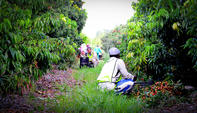Litchis also called lychees (Litchi chinensis Sonn.) are subtropical fruit native to China. The fruit grows on clusters on large evergreen trees which can take six to eight years to come into full production. Litchi trees need a lot of moisture and well-drained soil.

The South African Litchi Growers’ Association (SALGA) supports and manages litchi production and marketing in South Africa and can assist with advice on management practices for litchi.
Climate for Litchis
The best climate for litchis are areas that have long hot summers with high rainfall and humidity as this fruit crop has a substantial water requirement. Litchis need short, dry and cool winters (less than 15-20ºC) and cannot tolerate frost. The best litchi yields are achieved in areas with summer temperatures between 25-30°C and relative humidity over 60%.
Growing Litchis
The main litchi cultivars planted in South Africa are Mauritius (90% of commercial production and a mid-season cultivar) and McLean’s Red (less than 7% of commercial production and a late-season cultivar). Minor cultivars grown in the industry are Fay Zee Siu, Wai Chee (latest) and Early Delight (earliest).
Young trees should be bought from reputable nurseries and are planted at the beginning of the rainy season. Most litchi trees are propagated by air-layering. South African studies indicate that grafted litchi tree plants yielded no better than trees cultivated by air layering.
A thorough soil analysis before planting litchis will indicate any nutrient deficiency or excess. This can be adjusted during soil preparation and later during the growing season according to leaf analysis.
Litchis grow well in sandy soil in cooler areas but are equally productive in warmer areas on clay soil. They do not grow well in poorly drained soil or soil with impenetrable layers. Irrigation must be adapted according to soil type. For example, shorter, regular irrigation should be used for sandy soil.
Ideal planting width will depend on factors such as soil type and cultivar, but range from 12 x 12 m (65 trees/ha) to 10 x 5 m (200 trees/ha) in extensive systems. In semi-intensive systems plant width can be 8 x 4 m (312 trees/ha) or up to 6 x 4 m in cooler regions.
Litchi trees flower for up to 21 days during the South African spring. The flowers are ideally pollinated by bees as bee pollination promotes fruit set. The Agricultural Research Council (ARC) recommends two to four beehives/ha to be placed inside the orchard, away from human traffic.
Litchi fruit takes between 84 and 112 days to develop, depending on cultivar and production area. The average litchi fruit mass is between 16 and 35 g.
Fruit set (retention) can be improved by promoting pollination, providing micronutrients such as zinc and boron, girdling, pest control and optimizing irrigation.
Pests and Diseases of Litchis
The litchi moth, Natal fruit fly and false codling moth are the most serious litchi pests. The litchi moth has a similar life cycle to the macadamia nut borer. Other host plants of the litchi moth are macadamia, Bauhinia, Caesalpinia (plume flower trees) and Acacia species.
Other pests affecting litchi production include bark borer and nematodes.
Vervet monkeys, bats, birds, especially mousebirds and bulbuls also cause crop losses and fruit damage.
Post-harvest decay caused by fungi can cause fruit spoiling and shorten shelf life but can be limited by sulphur dioxide fumigation after harvesting.
By Marinda Louw